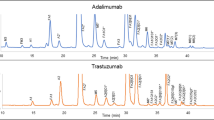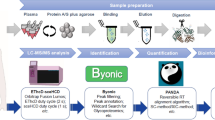Abstract
The site-specific quantitation of N- and O-glycosylation is vital to understanding the function(s) of different glycans expressed at a given site of a protein under physiological and disease conditions. Most commonly used precursor ion intensity based quantification method is less accurate and other labeled methods are expensive and require enrichment of glycopeptides. Here, we used glycopeptide product (y and Y0) ions and 18O–labeling of C-terminal carboxyl group as a strategy to obtain quantitative information about fold-change and relative abundance of most of the glycoforms attached to the glycopeptides. As a proof of concept, the accuracy and robustness of this targeted, relative quantification LC-MS method was demonstrated using Rituximab. Furthermore, the N-glycopeptide quantification results were compared with a biosimilar of Rituximab and validated with quantitative data obtained from 2-AB-UHPLC-FL method. We further demonstrated the intensity fold-change and relative abundance of 46 unique N- and O-glycopeptides and aglycopeptides from innovator and biosimilar samples of Etanercept using both the normal-MS and product ion based quantitation. The results showed a very similar site-specific expression of N- and O-glycopeptides between the samples but with subtle differences. Interestingly, we have also been able to quantify macro-heterogeneity of all N- and O-glycopetides of Etanercept. In addition to applications in biotherapeutics, the developed method can also be used for site-specific quantitation of N- and O-glycopeptides and aglycopeptides of glycoproteins with known glycosylation pattern.




Similar content being viewed by others
Abbreviations
- 2-AB:
-
2-amino benzamide
- AGP:
-
aglycopeptide or unoccupied glycopeptide
- Asp-N:
-
endoprotinase AspN;
- CE:
-
collision energy
- CID:
-
collision induced dissociation
- Cmc:
-
carboxymethylation
- DDA:
-
data-dependent acquisition
- DIA:
-
data-independent acquisition
- ECD:
-
electron capture dissociation
- ER:
-
endoplasmic reticulum
- ETD:
-
electron transfer dissociation
- Fuc:
-
fucose
- GalNAc:
-
N-acetylgalactosamine
- GlcNAc:
-
N-acetylglucosamine
- GP:
-
glycopeptide(s)
- HCD:
-
higher-energy collision dissociation
- HILIC:
-
hydrophilic interaction liquid chromatography
- IR:
-
insulin resistance
- iTRAQ:
-
isobaric tag for relative and absolute quantitation
- LC:
-
liquid chromatography
- Man:
-
mannose
- MRM:
-
multiple reaction monitoring
- MRM-HR:
-
multiple reaction monitoring – high resolution
- NeuAc:
-
N-acetylneuraminic acid
- PGC:
-
porous graphitized carbon
- PRM:
-
parallel reaction monitoring
- RP:
-
reversed phase
- RT:
-
retention time
- SILAC:
-
stable isotope labeling with amino acids in cell culture
- SPE:
-
solid phase extraction
- XIC:
-
extracted ion chromatogram
- UHPLC-FL:
-
Ultra-high performance liquid chromatography with fluorescence detector.
References
Babu P., North S.J., Jang-Lee J., Chalabi S., Mackerness K., Stowell S.R., Cummings R.D., Rankin S., Dell A., Haslam S.M.: Structural characterisation of neutrophil glycans by ultra sensitive mass spectrometric glycomics methodology. Glycoconj. J. 26, 975–986 (2009)
Wada Y., Azadi P., Costello C.E., Dell A., Dwek R.A., Geyer H., Geyer R., Kakehi K., Karlsson N.G., Kato K., et al.: Comparison of the methods for profiling glycoprotein glycans--HUPO human disease glycomics/proteome initiative multi-institutional study. Glycobiology. 17, 411–422 (2007)
Ito H., Kaji H., Togayachi A., Azadi P., Ishihara M., Geyer R., Galuska C., Geyer H., Kakehi K., Kinoshita M., et al.: Comparison of analytical methods for profiling N- and O-linked glycans from cultured cell lines : HUPO Human Disease Glycomics/Proteome Initiative multi-institutional study. Glycoconj. J. 33(3), 405–415 (2016)
Dong Q., Yan X., Liang Y., Stein S.E.: In-Depth Characterization and Spectral Library Building of Glycopeptides in the Tryptic Digest of a Monoclonal Antibody Using 1D and 2D LC-MS/MS. J. Proteome Res. (2016). doi:10.1021/acs.jproteome.5b01046
Madera M., Mechref Y., Novotny M.V.: Combining lectin microcolumns with high-resolution separation techniques for enrichment of glycoproteins and glycopeptides. Anal. Chem. 77, 4081–4090 (2005)
Alvarez-Manilla G., Atwood J., Guo Y., Warren N.L., Orlando R., Pierce M.: Tools for glycoproteomic analysis: size exclusion chromatography facilitates identification of tryptic glycopeptides with N-linked glycosylation sites. J. Proteome Res. 5, 701–708 (2006)
Wada Y., Tajiri M., Yoshida S.: Hydrophilic affinity isolation and MALDI multiple-stage tandem mass spectrometry of glycopeptides for glycoproteomics. Anal. Chem. 76, 6560–6565 (2004)
Hägglund P., Bunkenborg J., Elortza F., Jensen O.N., Roepstorff P.: A new strategy for identification of N-glycosylated proteins and unambiguous assignment of their glycosylation sites using HILIC enrichment and partial deglycosylation. J. Proteome Res. 3, 556–566 (2004)
Liu J., Wang F., Zhu J., Mao J., Liu Z., Cheng K., Qin H., Zou H.: Highly efficient N-glycoproteomic sample preparation by combining C18 and graphitized carbon adsorbents. Anal. Bioanal. Chem. 406, 3103–3109 (2014)
Huddleston M.J., Bean M.F., Carr S.A.: Collisional fragmentation of glycopeptides by electrospray ionization LC/MS and LC/MS/MS: methods for selective detection of glycopeptides in protein digests. Anal. Chem. 65, 877–884 (1993)
Saba J., Dutta S., Hemenway E., Viner R.: Increasing the productivity of glycopeptides analysis by using higher-energy collision dissociation-accurate mass-product-dependent electron transfer dissociation. Int. J. Prosthodont. 2012, 560391 (2012)
Wu S., Pu T., Viner R., Khoo K.: Novel LC-MS 2 product dependent parallel data acquisition function and data analysis work fl ow for sequencing and Identi fi cation of intact glycopeptides. Anal. Chem. 86, 5478–5486 (2014)
Khatri K., Staples G.O., Leymarie N., Leon D.R., Turiák L., Huang Y., Yip S., Hu H., Heckendorf C.F., Zaia J.: Confident assignment of site-specific glycosylation in complex glycoproteins in a single step. J. Proteome Res. 13, 4347–4355 (2014)
Parker B.L., Palmisano G., Edwards A.V.G., White M.Y., Engholm-Keller K., Lee A., Scott N.E., Kolarich D., Hambly B.D., Packer N.H., et al.: Quantitative N-linked Glycoproteomics of Myocardial Ischemia and Reperfusion Injury Reveals Early Remodeling in the Extracellular Environment. Mol. Cell. Proteomics. 10, M110.006833–M110.006833 (2011)
Parker B.L., Thaysen-Anderson M., Fazakerly D.J., Holliday M., Packer N.H., James D.E.: Terminal Galactosylastion and sialylation switching on membrane glycoproteins upon TNF-alpha-induced insulin resistance in adipocytes. Mol. Cell. Proteomics. 15(1), 141–153 (2015) epub:epub
Fenselau C., Yao X.: 18O2-labeling in quantitative proteomic strategies: a status report. J. Proteome Res. 8, 2140–2143 (2009)
Kristiansen T.Z., Harsha H.C., Grønborg M., Maitra A., Pandey A.: Differential membrane proteomics using 18O-labeling to identify biomarkers for cholangiocarcinoma. J. Proteome Res. 7, 4670–4677 (2008)
Kim J.-S., Fillmore T.L., Liu T., Robinson E., Hossain M., Champion B.L., Moore R.J., Camp D.G., Smith R.D., Qian W.-J.: 18O-Labeled Proteome Reference as Global Internal Standards for Targeted Quantification by Selected Reaction Monitoring-Mass Spectrometry. Mol. Cell. Proteomics. 10, M110.007302–M110.007302 (2011)
Schiestl M., Stangler T., Torella C., Cepeljnik T., Toll H., Grau R.: Acceptable changes in quality attributes of glycosylated biopharmaceuticals. Nat. Biotechnol. 29, 310–312 (2011)
Dimitrov D.S.M.J.: Therapeutic antibodies: coming, state and future trends–is a paradigm change soon? Methods Mol. Biol. 525, 1–27 (2009)
Glennie M.J., French R.R., Cragg M.S., Taylor R.P.: Mechanisms of killing by anti-CD20 monoclonal antibodies. Mol. Immunol. 44, 3823–3837 (2007)
Elliott S., Lorenzini T., Asher S., Aoki K., Brankow D., Buck L., Busse L., Chang D., Fuller J., Grant J., et al.: Enhancement of therapeutic protein in vivo activities through glycoengineering. Nat. Biotechnol. 21, 414–421 (2003)
Higuchi M., Oh-eda M., Kuboniwa H., Tomonoh K., Shimonaka Y., Ochi N.: Role of sugar chains in the expression of the biological activity of human erythropoietin. J. Biol. Chem. 267, 7703–7709 (1992)
Reusch D., Haberger M., Maier B., Maier M., Kloseck R., Zimmermann B., Hook M., Szabo Z., Tep S., Wegstein J., et al.: Comparison of methods for the analysis of therapeutic immunoglobulin G Fc-glycosylation profiles--part 1: separation-based methods. MAbs. 7, 167–179 (2015)
Domon B., Costello C.E.A.: Systematic nomenclature for carbohydrate fragmentations in FAB-MS/MS spectra of glycoconjugates. Glycoconj. J. 5, 397–409 (1988)
Maity S., Ullanat R., Lahiri S., Shekar S., Sodhan G., Vyas A., Dyaga G., Ireni S., Nair N., Sotsios Y., et al.: A non-innovator version of etanercept for treatment of arthritis. Biologicals. 39, 384–395 (2011)
Houel S., Hilliard M., Yu Y.Q., Meloughlin N.O., Millan S., Rudd P.M., William J.P., Chen W.: N- and O-Glycosylation Analysis of Etanercept using Liquid Chromatography and Quadrupole Time-of-Flight Mass Spectrometry Equipped with Electron Transfer Dissociation Functionality. Anal. Chem. 86, 576–584 (2014)
Tan Q., Guo Q., Fang C., Wang C., Li B., Wang H., Li J., Guo Y.: Characterization and comparison of commercially available TNF receptor 2-Fc fusion protein products. MAbs. 4, 761–774 (2012)
Huang L.-J., Lin J.-H., Tsai J.-H., Chu Y.-Y., Chen Y.-W., Chen S.-L., Chen S.-H.: Identification of protein O-glycosylation site and corresponding glycans using liquid chromatography-tandem mass spectrometry via mapping accurate mass and retention time shift. J. Chromatogr. A. 1371, 136–145 (2014)
Stavenhagen K., Hinneburg H., Thaysen-Andersen M., Hartmann L., Silva D.V., Fuchser J., Kaspar S., Rapp E., Seeberger P.H., Kolarich D.: Quantitative mapping of glycoprotein micro-heterogeneity and macro-heterogeneity: an evaluation of mass spectrometry signal strengths using synthetic peptides and glycopeptides. J. Mass Spectrom. 48, 627–639 (2013)
Zielinska D.F., Gnad F., Wiśniewski J.R., Mann M.: Precision mapping of an in vivo N-glycoproteome reveals rigid topological and sequence constraints. Cell. 141, 897–907 (2010)
Acknowledgments
We thank Department of Biotechnology, Govt. India, Ramaswamy, S. and Saiyed, T. of C-CAMP for their support. This work was supported through internal technology development funding to mass spectrometry facility of C-CAMP. We would like to thank AB Sciex, Pvt. Ltd. for supporting with mass spectrometer and accessories through collaboration. We thank the reviewers for their suggestion to improve readability of the manuscript.
Author contributions
PB conceived the project, designed experiments, analyzed data and written the paper. SJ and AR performed the experiments, analyzed the data and contributed to writing the paper.
Author information
Authors and Affiliations
Corresponding author
Ethics declarations
Conflicts of interest
The authors declare that they have no conflicts of interest.
Ethical approval
This article does not contain any studies with human participants or animals performed by any of the authors.
Electronic supplementary material
Rights and permissions
About this article
Cite this article
Srikanth, J., Agalyadevi, R. & Babu, P. Targeted, Site-specific quantitation of N- and O-glycopeptides using 18O–labeling and product ion based mass spectrometry. Glycoconj J 34, 95–105 (2017). https://doi.org/10.1007/s10719-016-9733-8
Received:
Revised:
Accepted:
Published:
Issue Date:
DOI: https://doi.org/10.1007/s10719-016-9733-8




